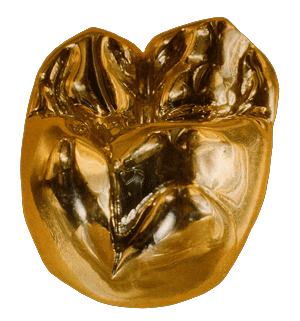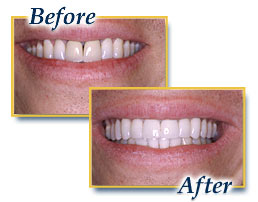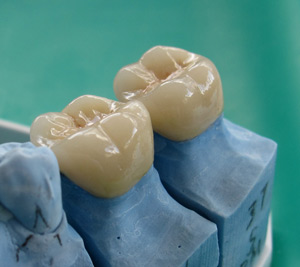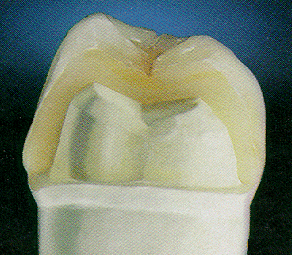 Dental Crowns
Dental Crowns
A dental crown as a cap which is shaped like a tooth that is placed over a naturally prepared tooth to cover the tooth and restore its shape and size, strength and to improve its appearance.
The main aim of dental crowns are to protect damaged, cracked or broken down teeth. A crown strengthens your existing, damaged tooth so as to preserve its functionality and its existence in our mouth.
 A Dental Crown may be needed in the following situations:
A Dental Crown may be needed in the following situations:
- If your tooth has undergone extensive decay and there is not enough remaining tooth structure to support a normal filling on the tooth
- If a large portion of your tooth has fractured and the natural shape of the tooth is almost non existent .
- If you have had a dental implant to replace a missing tooth, a crown will be fitted to the abutment of the titanium implant.
- To hold a dental bridge structure in place
- Following root canal treatment, the whole tooth is non vital (not alive anymore)Â a dental crown is often needed to strengthen the tooth as it becomes weak after the procedure.
- If you grind your teeth and have a poor diet, acid erosion may cause you to loose a lot of tooth structure, therefore a dental crown is indicated to replace the lost.
- For cosmetic reasons, To cover misshapen or severely discolored teeth to improve the aesthetics of your smile, you may opt for all porcelain cosmetic crowns.
How does the dentist prepare the natural tooth for a crown fitting procedure?
The dentist will prepare the tooth to the ideal shape for the crown. This will mean removing most of the outer surface, and leaving an inner core structure. Do not worry as the dentist will use an anesthetic solution so that no pain is felt. The amount of the tooth removed will be the same as the thickness of the crown to be fitted. Once the tooth is shaped, the dentist will take an impression of the prepared tooth, one of the opposite jaw and possibly another to mark the way you bite together. The impressions will be given to the technician for fabrication in the laboratory. When fabrication is completed, the crown will be cemented into place in the mouth.
The crowns, when cemented into place, fully encase the entire visible portion of a tooth that lies at and above the gum line depending on the location of the crown. For front teeth, the crowns finish line is at or below the gum line for aesthetic reasons, for back teeth it is the opposite.
 Types of Dental Crowns
Types of Dental Crowns
Dental crowns can be made of different type of materials. The final choice of material to be used would be based on the patient’s needs, financial ability and availability of the material. Different crown classification is based on the type of materials used.
Different types of crowns :
- All-ceramic or all porcelain dental crowns provide the best natural color match than any other crown type and may be more suitable for people with metal allergies. However, they are not as strong as porcelain-fused-to-metal crowns and they wear down opposing teeth a little more than metal or resin crowns. All-ceramic crowns are a good choice for front teeth.
- Porcelain fused metal crowns can be color matched with our natural teeth. They very much resemble natural tooth color shade. However, more wearing to the opposing teeth occurs with this crown type compared with metal or resin crowns. The crown’s porcelain portion can also chip or break off. Next to all-ceramic crowns, porcelain-fused-to-metal crowns look most like normal teeth. However, sometimes the metal underlying the crown’s porcelain can show through as a dark line, especially at the gum line and even more so if your gum’s recede. These crowns can be a good choice for front or back teeth.
- Metal Crowns . The metals used in crowns include gold alloy, nickel or chromium. Compared with other crown types, less tooth structure needs to be removed with metal crowns, and tooth wear to opposing teeth is kept to a minimum. Metal crowns withstand biting and chewing forces well and probably last the longest in terms of wear down. Also, metal crowns rarely chip or break. Some people like the color of the crown especially gold crowns as it might symbolize wealth status. Metal crowns are usually placed in backed teeth to avoid being seen when the patient smiles.
- All resin dental crowns made out of composite material, the same material used to do normal color fillings in our mouth. They are less expensive than other crown types. However, they wear down over time and are more prone to fractures than porcelain-fused-to-metal crowns.
- Temporary dental crown. Temporary crowns are made of acrylic, stainless steel and some even use gold . Temporary crowns can be used as a temporary restoration until a permanent crown is constructed by the dental laboratory. It is only used as a temporary alternative as they do not last very long in the mouth and are subject to rapid breakdown.

Pingback: Interested in the different types of Porcelain Dental Crowns? | Intelligent Dental
this is a very informative piece on crowns. metal crowns are placed on back teeth, not backed teeth,where they are less visible when the mouth is open.
thanks for the good clear writing.
opps; i am on tlordisms@gmail.com
Pingback: How to Decide Between a Dental Bridge and a Post | Intelligent Dental